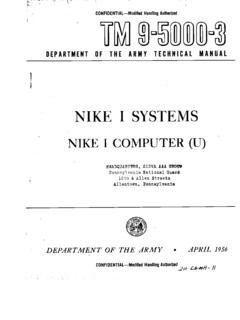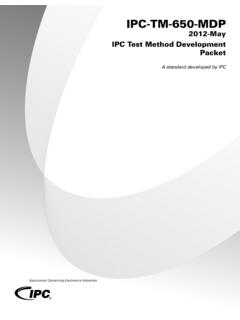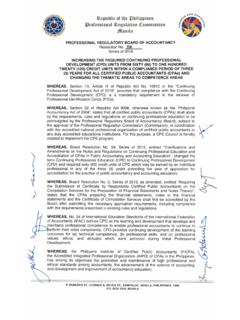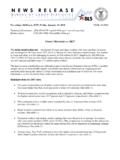Transcription of DEPARTMENT OF DEFENSE STANDARD …
1 NOT MEASUREMENTSENSITIVEMIL-STD-196E17 February 1998 SUPERSEDINGMIL-STD-196D19 JANUARY 1985 DEPARTMENT OF DEFENSESTANDARD PRACTICEJOINT ELECTRONICSTYPE DESIGNATION SYSTEMAMSC A7288 AREA CMANDISTRIBUTION STATEMENT A. Approved for public release; distribution is OF DEFENSEWASHINGTON, 20360 joint Electronics Type Designation SystemMIL-STD-196E1. This specification is approved for use by all Departments and agencies of theDepartment of Beneficial comments (recommendations, additions, deletions) of any pertinent datawhich may be of use in improving this document should be addressed to: Commander, Communications-Electronics Command, ATTN: AMSEL-LC-LEO-E-EP, Ft. Monmouth,New Jersey 07703, by using the Standardization Document Improvement Proposal (DD Form1426) appearing at the end of this document or by The joint Electronics Type Designation System (JETDS) which was formerlyknown as the joint Army-Navy Nomenclature System (AN System) and the JointCommunications-Electronics Nomenclature System, was adopted 16 February 1943 by the JointCommunications Board for joint Army-Navy use, and approved by the CombinedCommunications Board of 17 February 1943 for all new Army, and new Navy airborne,radio, and radar equipment.
2 Further, on 26 November 1943, the joint Communications Boardapproved the extension of the scope of the system to include equipment designed by the Navyspecifically for Marine Corps and amphibious use. On 1 August 1946, the Bureau of Ships, DEPARTMENT of the Navy, adopted the system for use on ship, submarine, and ground electronicequipment. Similar action was taken by the Bureau of Ordnance, DEPARTMENT of the Navy, on 18 October 1946, to cover the electronic portions of its fire-control systems. The Air Force,upon its establishment as a separate DEPARTMENT , continued the use of the system for electronicequipment. On 16 January 1950, the Coast Guard adopted the system to identify anyelectronic equipment which it may develop or adopt. On 16 August 1951, the JointCommunications-Electronics Committee of the joint Chiefs of Staff approved Canadianintegration with the AN nomenclature system.
3 On 8 June 1953, the Office of the Chief ofOrdnance, DEPARTMENT of the Army, adopted the system for its use. In 1957 the DEPARTMENT ofDefense approved MIL-STD-196 joint Electronics Type Designator System . In 1959 theNational Security Agency started using the system. In 1960 the DEPARTMENT of DEFENSE approvedMIL-STD-196A; in April 1965, MIL-STD-196B; in April 1971, MIL-STD-196C; and in January1985, MIL-STD-196D. On May 1981, Chief, Office of International Research Development andStandardization, DEPARTMENT of the Army, directed implementation of the MIL-STD-196 forintegration of New Zealand, Australia and Great Britain into this JETDS system is operated in accordance with basic policies of the Office of the AssistantSecretary of DEFENSE , (Installation and Logistics), Tri-Service Regulations, AR 105-19, APR82-2and NAVMATINST-10550-14 and MCO 10550-8, joint electronic Type Designation System,International Agreements and referenced documents , standards and government documents, drawings or item item (repair) parts Part of Used with but not Part of of functions6 MIL-STD-196 EvCONTENTS control point (DCP) of DEFENSE Control Point (DODCP)
4 64 General of nomenclature nomenclature of of on for of approved letter for a variable item letter for specific configuration of a variable item letters not to be of of cancelled designators for definitive systems, subsystems, centers, centrals and designators for definitive designators for definitive designator for one end item designator for multiple usage10 MIL-STD-196 EviCONTENTS designator for dual item of complement designator for variable systems, subsystems, centers, centrals, sets, groups and by parenthetical (V) of a variable to a higher item level of which it is a data for variable configurations of designator for units designed to accept Plug-Ins for cryptographic/classified of automated data processing Equipment (ADPE) designators for equipment designed for training set , subsystems, and sets with same indicator , subsystems, and sets with different indicator designator for a group or test equipment produced as separate and test units which are an integral part of basic installation indicator letters requiring further indicator letter C indicator letter D indicator letter F indicator letter G indicator letter M indicator letter P indicator letter S indicator letter T indicator letter U 13 MIL-STD-196 EviiCONTENTS indicator letter V type indicator letters requiring further indicator letter P indicator letter Z purpose indicator letters requiring further indicator letter Q indicator letter Z of systems, subsystems, centers, centrals, sets.
5 Groups and units with modified power of type designators todevelopmental/experimental assignments requiring further designators which include the parenthetical (-FT, -IN) with varying batteries - type storage batteries on nomenclature Data Item Descriptions (DIDs) control of the Army Control of the Navy Control of the Air Force Control Security Agency Control Control of DEFENSE Control nomenclature requests, and data Designation Automated System (TDAS) term (key word) from previous Issue17 MIL-STD-196 EviiiAPPENDIX - FOREIGN GOVERNMENT foreign of of equipment Zealand Kingdom letter by the United States Military Services and by participating country , subsystems, centers, centrals and and unit of technical of technical and secret equipment47 MIL-STD-196 EixFIGURESF igurePage1 Request for nomenclature (DD Form 61)262 Example of a new assignment283 Example of a variable assignment (includes 2 DD61s: assignment of a basic (v))304 Example of cancellation335 Example of a revision356 Example of a modification letter assignment377 Example of TDAS Source Request Number Format(as Proposed)398 How to fill out a Request for Nomenclature(DD Form 61)40 TABLEST ablePageITable of equipment indicators18 IITable of group indicators19 IIIT able of unit indicators20 MIL-STD-196E11.
6 Purpose. The purpose of this document is to standardize the preparation of Requestsfor Nomenclature and the assignment of type designations for electronic items under the JointElectronics Type Designation System (JETDS). Scope. This document establishes uniform procedures for the assignment of typedesignations for the electronic materiel listed Radios (including telemetry, relay and terminal equipment).b. Radar (including identification and recognition equipment).c. Data processing units (including electronic and electromechanical computers).d. Flight control and aids to the navigation of aircraft, guided missiles, ships and spacevehicles (including automatic and remote control, automatic pilot and air data computers which may be tied into fire-control, instrument landing, navigation, and data link equipment).e. Weapons control systems (including evaluation and scoring of gun, missile, bomb, andunderwater weapons control).
7 F. electronic countermeasures (including electronic deception and electronic jamming).g. Radiacs (Radioactive detection, indication and computation devices).h. Infrared Meteorological Magnetic amplifier and detection Wired communications systems (including telephone, telegraph, teletype, facsimile,interphone, public address, recorders, and reproducers).m. Fiber Optics and associated Equipment for the detection of noise and interference in the radio frequency Underwater sound radiating and non-radiating equipment including those for listening,ranging, sounding, communication, and object Training and instruction equipment for any of the Auxiliary and/or accessory equipment to the preceding kinds of Satellites and associated Robotic Maintenance / Support APPLICABLE General. The documents listed in this section are specified in sections 3, 4, and 5 of thisstandard.
8 This section does not include documents cited in other sections of this STANDARD orrecommended for additional information or as examples. While every effort has been made toensure the completeness of this list, document users are cautioned that they must meet allspecified requirements documents cited in sections 3, 4, and 5 of this STANDARD , whether or notthey are Government Specifications, standards and handbooks. The following specifications, standards andhandbooks form a part of this document to the extent specified herein. Unless otherwise specified,the issues of these documents are those listed in the latest issue of the DEPARTMENT of DefenseIndex of Specifications and Standards (DoDISS) and supplement thereto, cited in the solicitation(see ). DEPARTMENT OF DEFENSE STANDARDSMIL-STD-100- Engineering Drawing PracticesDEPARTMENT OF DEFENSE HANDBOOKSH6- Cataloging Handbook, Section A, Federal Item NameDirectory for Supply Cataloging.
9 (Unless otherwise indicated, copies of the above specifications, standards and handbooks areavailable from the Standardization Document Order Desk, 700 Robbins Avenue, Building 4D,Philadelphia, PA. 19111-5094.) Other government documents, drawings and publications. The following otherGovernment documents drawings, and publications form a part of this document to the extentspecified herein. Unless otherwise specified, the issues are those cited in the DEPARTMENT of DEFENSE Industrial Security forSafeguarding Classified Information(Application for copies of DOD should be addressed to the Superintendent ofDocuments, Government Printing Office, Washington, 20402-0001.) Order of precedence. In the event of a conflict between the text of this document andthe references cited herein, the text of this document shall take precedence. Nothing in thisdocument, however, supersedes applicable laws and regulations unless a specific exemption hasbeen Definitions.
10 For the purpose of this document, the following definitions Nomenclature. The combination of an item name and a type designator. These aredefined as Item name. A name published in the Federal Cataloging Handbook H6, or thatname developed by the requestor in accordance with MIL-STD-100, the portion applicable todrawing titles. Item names used with type designator assignments will be consistent with thepolicies of the Federal Cataloging Program. Examples of unacceptable item names includeabbreviations, acronyms, descriptions of size, frequencies, Type designator. A combination of letters and numbers arranged in a specificsequence to provide a short significant method of electronic materiel. electronic materiel, from a military point of view, generallyincludes those electronic devices employed in data processing, detection and tracking(underwater, sea, land-based, air and space), recognition and identification, communications, aidsto navigation, weapons control and evaluation, flight control, and electronics countermeasures.






